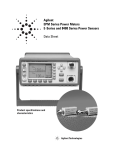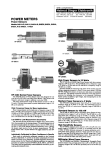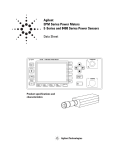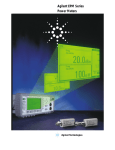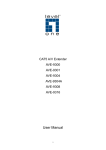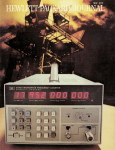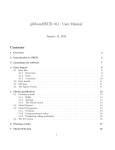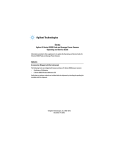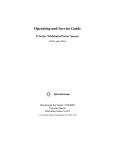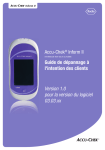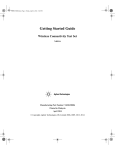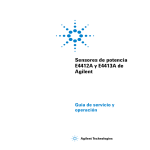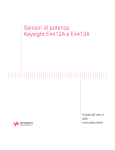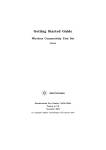Download The Keysight E-Series E9300 Power Sensors in Detail
Transcript
Keysight E-Series E9300 Power Sensors Operating and Service Guide Notices © Keysight Technologies 2006 - 2015 Warranty No part of this manual may be reproduced in any form or by any means (including electronic storage and retrieval or translation into a foreign language) without prior agreement and written consent from Keysight Technologies as governed by United States and international copyright laws. The material contained in this document is provided “as is,” and is subject to being changed, without notice, in future editions. Further, to the maximum extent permitted by applicable law, Keysight disclaims all warranties, either express or implied, with regard to this manual and any information contained herein, including but not limited to the implied warranties of merchantability and fitness for a particular purpose. Keysight shall not be liable for errors or for incidental or consequential damages in connection with the furnishing, use, or performance of this document or of any information contained herein. Should Keysight and the user have a separate written agreement with warranty terms covering the material in this document that conflict with these terms, the warranty terms in the separate agreement shall control. Manual Part Number E9300-90016 Edition Edition 12, June 26, 2015 Printed in Malaysia Keysight Technologies 1400 Fountaingrove Parkway Santa Rosa, CA 95403 Technology Licenses The hardware and/or software described in this document are furnished under a license and may be used or copied only in accordance with the terms of such license. Restricted Rights Legend U.S. Government Restricted Rights. Software and technical data rights granted to the federal government include only those rights customarily provided to end user customers. Keysight provides this customary commercial license in Software and technical data pursuant to FAR 12.211 (Technical Data) and 12.212 (Computer Software) and, for the Department of Defense, DFARS 252.227-7015 (Technical Data - Commercial Items) and DFARS 227.7202-3 (Rights in Commercial Computer Software or Computer Software Documentation). ii Safety Notices CAUTION A CAUTION notice denotes a hazard. It calls attention to an operating procedure, practice, or the like that, if not correctly performed or adhered to, could result in damage to the product or loss of important data. Do not proceed beyond a CAUTION notice until the indicated conditions are fully understood and met. WA R N I N G A WARNING notice denotes a hazard. It calls attention to an operating procedure, practice, or the like that, if not correctly performed or adhered to, could result in personal injury or death. Do not proceed beyond a WARNING notice until the indicated conditions are fully understood and met. E9300 Operating and Service Manual Certification Keysight Technologies certifies that this product met its published specifications at the time of shipment. Keysight further certifies that its calibration measurements are traceable to the United States National Institute of Standard and Technology (formerly National Bureau of Standards), to the extent allowed by that organization’s calibration facility, and to the calibration facilities of other International Standards Organization members. Warranty This Keysight Technologies instrument product is warranted against defects in material and workmanship for a period of 3 years from date of shipment. During the warranty period, Keysight Technologies will at its option, either repair or replace products which prove to be defective. For warranty service or repair, this product must be returned to a service facility designated by Keysight Technologies. Buyer shall prepay shipping charges to Keysight Technologies and Keysight Technologies shall pay shipping charges, duties, and taxes for products returned to Keysight Technologies from another country. Keysight Technologies warrants that its software and firmware designated by Keysight Technologies for use with an instrument will execute its programming instructions when properly installed on that instrument. Keysight Technologies does not warrant that the operation of the instrument, or firmware will be uninterrupted or error free. Limitation of Warranty The foregoing warranty shall not apply to defects resulting from improper or inadequate maintenance by Buyer, Buyer-supplied software or interfacing, unauthorized modification or misuse, operation outside of the environmental specifications for the product, or improper site preparation or maintenance. NO OTHER WARRANTY IS EXPRESSED OR IMPLIED. KEYSIGHT TECHNOLOGIES SPECIFICALLY DISCLAIMS THE IMPLIED WARRANTIES OF MERCHANTABILITY AND FITNESS FOR A PARTICULAR PURPOSE.. E9300 Operating and Service Manual iii Exclusive Remedies THE REMEDIES PROVIDED HEREIN ARE BUYER’S SOLE AND EXCLUSIVE REMEDIES. KEYSIGHT TECHNOLOGIES SHALL NOT BE LIABLE FOR ANY DIRECT, INDIRECT, SPECIAL, INCIDENTAL, OR CONSEQUENTIAL DAMAGES, WHETHER BASED ON CONTRACT, TORT, OR ANY OTHER LEGAL THEORY. iv E9300 Operating and Service Manual Restricted Rights Legend The Software and Documentation have been developed entirely at private expense. They are delivered and licensed as “commercial computer software” as defined in DFARS 252.227-7013 (Oct 1988), DFARS 252.211-7015 (May 1991), or DFARS 252.227-7014 (Jun 1995), as a “commercial item” as defined in FAR 2.101(a), or as “restricted computer software” as defined in FAR 52.227-19 (Jun 1987) (or any equivalent agency regulation or contract clause), whichever is applicable. You have only those rights provided for such Software and Documentation by the applicable FAR or DFARS clause or the Keysight standard software agreement for the product involved. Technology Licenses The hardware and/or software described in this document are furnished under a license and may be used or copied only in accordance with the terms of such license. E9300 Operating and Service Manual v Safety Summary The following general safety precautions must be observed during all phases of operation of this instrument. Failure to comply with these precautions or with specific warnings elsewhere in this manual violates safety standards of design, manufacture, and intended use of the instrument. Keysight Technologies assumes no liability for the customer’s failure to comply with these requirements. Safety Notices vi WA R N I N G A WARNING notice denotes a hazard. It calls attention to an operating procedure, practice, or the like that, if not correctly performed or adhered to, could result in personal injury or loss of life. Do not proceed beyond a WARNING notice until the indicated conditions are fully understood and met. CAUTION A CAUTION notice denotes a hazard. It calls attention to an operating procedure, practice, or the like that, if not correctly performed or adhered to, could result in damage to the product or loss of important data. Do not proceed beyond a CAUTION notice until the indicated conditions are fully understood and met. E9300 Operating and Service Manual General Safety Information The following general safety precautions must be observed during all phases of operation, service and repair of this sensor. Failure to comply with these precautions or specific warnings elsewhere in this manual violates safety standards of design manufacture and intended use of the sensor. Keysight Technologies assumes no liability for the customer’s failure to comply with these requirements. The Instruction Documentation Symbol. The product is marked with this symbol when it is necessary for the user to refer to the instructions in the supplied documentation. WA R N I N G BEFORE CONNECTING THE POWER SENSOR TO OTHER INSTRUMENTS, ensure that all instruments are connected to the protective (earth) ground. Any interruption of the protective earth grounding will cause a potential shock hazard that could result in personal injury. Sound Emission Herstellerbescheinigung Diese Information steht im Zusammenhang mit den Anforderungen der Maschinenlarminformationsverordnung vom 18 Januar 1991. • Sound Pressure LpA < 70 dB. • Am Arbeitsplatz. • Normaler Betrieb. • Nach DIN 45635 T. 19 (Typprufung). E9300 Operating and Service Manual vii Manufacturers Declaration This statement is provided to comply with the requirements of the German Sound DIN 45635 T. 19 (Typprufung). • Sound Pressure LpA < 70 dB. • At operator position. • Normal operation. • According to ISO 7779 (Type Test). viii E9300 Operating and Service Manual Power Meter Front Panel Operation This guide uses the following symbols to denote power meter front panel keys and display legends. A function name in a keycap symbol indicates the use of a key physically located on the power meter’s front panel. Softkey Label Display Text E9300 Operating and Service Manual A function name in display-font indicates the use of a key down the right side of the power meter’s display adjacent to the displayed text. Display TextText shown in this font indicates message text displayed by the power meter. ix Documentation Sensors Covered by Manual These sensors have a two-part serial number: the prefix (two letters and the first four numbers), and the suffix (the last four numbers). The two letters identify the country in which the unit was manufactured. The four numbers of the prefix are a code identifying the date of the last major design change incorporated in your sensor. The four-digit suffix is a sequential number and, coupled with the prefix, provides a unique identification for each unit produced. The contents of this manual apply directly to all serial numbers unless otherwise indicated. Related Publications The Keysight E-Series E9300 Power Sensors Operating and Service Guide is also available in the following languages: • English Language Operating and Service Guide - Standard • German Language Operating and Service Guide - Option ABD • Spanish Language Operating and Service Guide - Option ABE • French Language Operating and Service Guide - Option ABF • Japanese Language Operating and Service Guide - Option ABJ • Italian Language Operating and Service Guide - Option ABZ • Korean Language Operating and Service Guide - Option AB1 Further useful information can be found in: • Application Note 64-1B, Fundamentals of RF and Microwave Power Measurements, available by ordering through your local Keysight Technologies Sales Office. • The Keysight EPM Series Power Meter User’s Guide and Programming Guide. x E9300 Operating and Service Manual In This Guide ... 1 Introduction Chapter 1 introduces you to the general information about the E-Series E9300 power sensor. 2 Making Measurements Chapter 2 describes the general operation of the E-Series E9300 power sensor. 3 Specifications and Characteristics Chapter 3 describes the specifications and characteristics of your E-Series E9300 power sensor. 4 Service Chapter 4 describes the performance test, replaceable parts and service of the E-Series E9300 power sensor. E9300 Operating and Service Manual xi THIS PAGE HAS BEEN INTENTIONALLY LEFT BLANK. xii E9300 Operating and Service Manual Contents 1 Introduction 1 General Information 3 Accessories Shipped with the Instrument 4 Power Meter Requirements 4 The Keysight E-Series E9300 Power Sensors in Detail 4 Getting Started 7 Initial Inspection 7 Checking Power Meter Firmware and DSP Revision 7 Interconnections and Calibration 8 Recommended Calibration Interval 10 Specifications 10 2 Making Measurements 11 Power Meter Configuration Changes 13 Measuring Spread Spectrum and Multitone Signals 14 CDMA Signal Measurements 15 Multitone Signal Measurements 16 Measuring TDMA Signals 17 Electromagnetic Compatibility (EMC) Measurements 19 Measurement Accuracy and Speed 20 E9300 Operating and Service Manual xiii Contents 3 Specifications and Characteristics 23 Introduction 24 E9300/1/4/A Power Sensor Specifications 26 Frequency Range 26 Connector Type 26 Maximum SWR (25 °C ± 10 °C) 26 Maximum SWR (0 °C to +55 °C) 27 Maximum Power 28 Maximum DC Voltage 29 Power Linearity 30 Additional Power Linearity Error Due to Change in Temperature 32 Switching Point 33 Zero Set, Zero Drift and Measurement Noise 34 Settling Time 34 Calibration Factor and Reflection Coefficient 36 Cal Factor Uncertainty (Lower Power Path, –60 to –10 dBm) 37 Cal Factor Uncertainty (High Power Path, –10 to +20 dBm) 37 General 38 E9300/1B and H Power Sensor Specifications 39 Frequency Range 39 Connector Type 39 Maximum SWR (25 °C ± 10 °C) 39 Maximum SWR (0 °C to +55 °C) 40 Maximum Power 41 Power Linearity 42 Additional Power Linearity Error due to Change in Temperature 44 Switching Point 45 Calibration Factor and Reflection Coefficient 48 Cal Factor Uncertainty (Low Power Path) 49 xiv E9300 Operating and Service Manual Contents Cal Factor Uncertainty (High Power Path) 50 General Characteristics 51 References 51 4 Service 51 General Information 52 Cleaning 52 Connector Cleaning 52 Performance Test 53 Standing Wave Ratio (SWR) and Reflection Coefficient (Rho) Performance Test 53 Replaceable Parts 55 Service 59 Principles of Operation 59 Troubleshooting 60 Repair of Defective Sensor 60 Disassembly Procedure 60 Reassembly Procedure 61 E9300 Operating and Service Manual xv Contents THIS PAGE HAS BEEN INTENTIONALLY LEFT BLANK. xvi E9300 Operating and Service Manual Figures Figure 1-1 Figure 1-2 Typical Keysight E-Series E9300 power sensors. 3 Simplified Block Diagram of Diode Pair/Attenuator/Diode Pair 5 Figure 1-3 Power Meter Firmware Version Screen 7 Figure 2-4 Auto-averaging Settings 13 Figure 2-5 Example of an 8 MHz bandwidth digital television signal 14 Figure 2-6 Wideband CDMA Error of Keysight E-Series E9300 power sensor versus corrected CW sensor 15 Figure 2-7 CDMA (IS-95A): 9Ch Fwd 15 Figure 2-8 Calibration Factors versus Frequency 16 Figure 3-1 Typical SWR 10 MHz to 18 GHz (25 °C ± 10 °C) 28 Figure 3-2 Typical SWR 9 kHz to 6 GHz (25 °C ±10 °C) E9304A 28 Figure 3-3 Typical Power Error Introduced in a Keysight E9304A power sensor by DC Voltage 29 Figure 3-4 Typical Power Linearity at 25 °C, after zero and calibration, with associated Measurement Uncertainty 30 Figure 3-5 Relative Mode Power Measurement Linearity with Keysight EPM power meter at 25 °C ±10 °C (typical) 32 Figure 3-6 Autofilter, default resolution, 10 dB decreasing power step (not across the switching point) 35 Figure 3-7 E9300B Typical SWR (25 °C ± 10 °C) 40 Figure 3-8 E9300H Typical SWR 10 MHz to 18 GHz (25 °C ± 10 °C) 41 Figure 3-9 E9300B Typical Power Linearity at 25 °C, after zero and calibration with associated Measurement Uncertainty 42 Figure 3-10 E9300H Typical Power Linearity at 25 °C, after zero and calibration with associated Measurement Uncertainty 43 Figure 3-11 Relative Mode Power Measurement Linearity with Keysight EPM power meter at 25 °C ± 10 °C (typical) 45 Figure 3-12 E9300/1B & H Autofilter, default resolution, 10 dB decreasing power step (not across the switching point) 48 E9300 Operating and Service Manual xvii Figures Figure 4-1 Figure 4-2 xviii Illustrated Parts Break down 56 Removing Power Sensor Shell 61 E9300 Operating and Service Manual Tables Table 2-1 Sensor Ranges 20 Table 2-2 Range Crossover Values 21 Table 4-3 Power Sensor SWR and Reflection Coefficient for the E9300A 53 Table 4-4 Power Sensor SWR and Reflection Coefficient for the E9301A 53 Table 4-5 Power Sensor SWR and Reflection Coefficient for the E9304A 54 Table 4-6 Power Sensor SWR and Reflection Coefficient for the E9300A 54 Table 4-7 Power Sensor SWR and Reflection Coefficient for the E9301B 54 Table 4-8 Power Sensor SWR and Reflection Coefficient for the E9300H 55 Table 4-9 Power Sensor SWR and Reflection Coefficient for the Keysight E9301H 55 E9300 Operating and Service Manual xix Tables THIS PAGE HAS BEEN INTENTIONALLY LEFT BLANK. xx E9300 Operating and Service Manual Keysight E-Series E9300 Power Sensors Operating and Service Guide 1 Introduction General Information 3 Getting Started 6 1 Introduction What You’ll Find In This Chapter This Chapter introduces you to the Keysight E- Series E9300 power sensors, some detail on their operation, the minimum power meter requirements and connecting to your power meter. It contains the following sections: “General Information” on page 3 “The Keysight E- Series E9300 Power Sensors in Detail” on page 4 “Getting Started” on page 6 Figure 1-1 Typical Keysight E-Series E9300 power sensors. 2 E9300 Operating and Service Manual Introduction 1 General Information Welcome to the Keysight E- Series E9300 power sensors Operating and Service Guide! This guide contains information about the initial inspection, operation, specifications and repair of the Keysight E- Series E9300 power sensors. Use this guide as a supplement to the Keysight EPM series power meters User’s Guides. It is 3- hole drilled to allow you to retain it in the power meter’s binder. All power meter functions are detailed in the Keysight EPM series power meters User’s Guide and Programming Guide, however, this guide contains information specific to the operation of Keysight E- Series E9300 power sensor. Accessories Shipped with the Instrument The following items are shipped with every purchase of E9300 Series power sensor: • Certificate of Calibration • E9300 Series Power Sensors Operating and Service Guide Verify that any options ordered are included with the shipment by checking the packing list included with the shipment. Power Meter Requirements The Keysight E- Series E9300 power sensors are NOT compatible with the earlier Keysight 430- Series, Keysight E1416A, or Keysight 70100A power meters. They are compatible ONLY with the Keysight EPM series power meters. Also, not all Keysight EPM series power meters are immediately compatible - your power meter must use firmware and Digital Signal Processing (DSP) code from a specific release onwards. see “Checking Power Meter Firmware and DSP Revision” on page 6 tells you how to check your power meter and have it upgraded if required. E9300 Operating and Service Manual 3 1 Introduction The Keysight E-Series E9300 Power Sensors in Detail Most power sensors used for measuring average power employ either thermocouple or diode technologies. Diode based sensors frequently rely on the application of correction factors to extend their dynamic range beyond their square law response region, typically –70 dBm to –20 dBm. However, while this technique achieves wide dynamic range capability, it is limited to continuous wave (CW) signals outside the square law region. Modulated signals must be padded down or at low levels, with their average and peak power levels within the diode square law region, to be measured accurately. Accurate, average power measurement of high level signals carrying modulation cannot be obtained using a CW correction factor technique. Specialized modulation sensors provide accurate measurements but are bandwidth limited. The Keysight E- Series E9300 power sensors are true average, wide dynamic range RF microwave power sensors. They are based on a dual sensor diode pair/attenuator/diode pair proposed by Szente et. al. in 1990*. Figure 1- 2 shows a block diagram of this technique. Low Sense+ Lower Range (–60 dBm to –10 dBm) RF in Low Sense– High Sense+ Upper Range (–10 dBm to +20 dBm) High Sense– Figure 1-2 Simplified Block Diagram of Diode Pair/Attenuator/Diode Pair 4 E9300 Operating and Service Manual Introduction 1 This technique ensures the diodes in the selected signal path are kept in their square law region, thus the output current (and voltage) is proportional to the input power. The diode pair/attenuator/diode pair assembly can yield the average of complex modulation formats across a wide dynamic range, irrespective of signal bandwidth. The dual range Modified Barrier Integrated Diode (MBID)† package includes further refinements to improve power handling allowing accurate measurement of high level signals with high crest factors without incurring damage‡ to the sensor. These sensors measure average RF power on a wide variety of modulated signals and are independent of the modulation bandwidth. They are ideally suited to the average power measurement of multi- tone and spread spectrum signals such as CDMA, W- CDMA and digital television formats. Also, pulsed, TDMA signals can be measured within the constraints detailed in Chapter 2, “Measuring TDMA Signals” on page 17. The results are displayed on a compatible# power meter in logarithmic (dBm or dB) or linear (Watts or %) measurement units. * US Patent #4943764, assigned to Keysight Technologies. † November 1986 Hewlett-Packard Journal pages 14-2, “Diode Integrated Circuits for Millimeter-Wave Applications”. ‡ Refer Chapter 3, Maximum Power on page 28 and page 41 to for maximum power handling specifications. # A Keysight EPM-Series power meter is required as specified in the section see “Checking Power Meter Firmware and DSP Revision” on page 6. E9300 Operating and Service Manual 5 1 Introduction Getting Started Initial Inspection Inspect the shipping container for damage. If the shipping container or packaging material is damaged, it should be kept until the contents of the shipment have been checked mechanically and electrically. If there is mechanical damage, notify the nearest Keysight Technologies office. Keep the damaged shipping materials (if any) for inspection by the carrier and a Keysight Technologies representative. If required, you can find a list of Keysight Technologies Sales and Service offices on page 63. Checking Power Meter Firmware and DSP Revision Before proceeding, first ensure your Keysight EPM series power meter has the required firmware and DSP revisions (E4418B and E4419B only) for the correct operation of your Keysight EPM series power meters. On the power meter press , , Service , Version . Firmware Revision Code (dual channel) DSP Revision Code Figure 1-3 Power Meter Firmware Version Screen 6 E9300 Operating and Service Manual Introduction 1 First check the section labelled DSP Revision:. Release A.01.11 or later is required. If your power meter has an earlier release, please contact your nearest Service Office (listed on page 63) to arrange an upgrade. Next check the section labelled Main F/W Rev:. Release A1.04.00 or later is required for single channel meters; release A2.04.00 or later is required for dual channel meters. For E9300 power sensors with suffix ‘B’ or ‘H’, firmware revision A1.06.00 or later is required for single channel meters; revision A2.06.00 or later is required for dual channel meters. If your power meter has an earlier release, please contact your nearest Keysight Service Office (listed on page 63) to arrange an upgrade. NOTE You can carry out the firmware upgrade yourself if your power meter has the required. Access http://www.keysight.com/find/powermeters and click on the link: “EPM Series E4418B Single-Channel Power Meter” or “EPM Series E4419B Dual-Channel Power Meter”. Click the “Software, Firmware and Drivers” link and follow the downloading instructions. Interconnections and Calibration Connect one end of a Keysight 11730 series sensor cable to the Keysight E- series E9300 power sensor and connect the other end of the cable to the power meter’s channel input. Allow a few seconds for the power meter to download the power sensor’s calibration table. CAUTION The Keysight 9304A Sensor is DC coupled. DC voltages in excess of the maximum value (5 Vdc) can damage the sensing diode. NOTE Ensure power sensors and cables are attached and removed in an indoor environment. E9300 Operating and Service Manual 7 1 Introduction To carry out a zero and calibration cycle as requested by the power meter proceed as follows: • Ensure the Keysight E- Series E9300 power sensor is disconnected from any signal source. • When calibrating Keysight E- Series E9300B or E9301B sensors, first remove the attenuator. • On the power meter, press , Zero (or Zero A / Zero B ). During zeroing the wait symbol is displayed. • When the wait period is complete connect the Keysight E- Series power sensor to the power meter’s POWER REF output. • Press Cal (or Cal , Cal A / Cal B ). The wait symbol is again displayed during calibration. On completion the power meter and sensor are ready to connect to the device under test (DUT). Ensure the attenuator is re- connected to the Keysight E- Series E9300B or E9301B sensors prior to making measurements. CAUTION WA R N I N G 8 The Keysight E-Series E9300B or E9301B sensors should not be operated without the attenuator connected at any time other than for calibration. You must ensure the attenuator is reconnected following calibration. BEFORE CONNECTING THE POWER SENSOR TO OTHER INSTRUMENTS ensure that all instruments are connected to the protective (earth) ground. Any interruption of the protective earth grounding will cause a potential shock hazard that could result in personal injury. E9300 Operating and Service Manual Introduction 1 The measurement connector (for connection to DUT) is Type- N (male) for all the Keysight E- Series E9300 power sensors. A torque wrench should be used to tighten these connectors. Use a 3/4- inch open- end wrench and torque to 12 in- lb (135 Ncm) for the Type- N connector. Recommended Calibration Interval Keysight Technologies recommends a one- year calibration cycle for the E9300 series power sensors. Specifications The specifications listed in Chapter 3, “Specifications and Characteristics”, are the performance standards or limits against which the power sensor may be tested. These specifications are valid ONLY after proper calibration of the power meter. Refer to the “Calibration Procedure Using Keysight E- Series Power Sensors” in your Keysight EPM series power meter User’s Guide. Use the plastic flange cover to protect the waveguide connector from dirt and mechanical damage whenever it is not in use. Any burn, dents or dirt on the flange or waveguide surface will increase the SWR and change the Cal Factor. Refer to the power meter operating and service manual for interconnecting instructions. E9300 Operating and Service Manual 9 1 Introduction THIS PAGE HAS BEEN INTENTIONALLY LEFT BLANK. 10 E9300 Operating and Service Manual Keysight E-Series E9300 Power Sensors Operating and Service Guide 2 Making Measurements Power Meter Configuration Changes 13 Measuring Spread Spectrum and Multitone Signals 14 CDMA Signal Measurements 15 Multitone Signal Measurements 16 Measuring TDMA Signals 17 Electromagnetic Compatibility (EMC) Measurements 19 Measurement Accuracy and Speed 20 2 Making Measurements What You’ll Find In This Chapter This Chapter shows you how to use the Keysight E- Series E9300 power sensors to make power measurements on signals with different modulation formats. For all other operations please refer to your Keysight EPM series power meter User’s Guide. This chapter contains the following sections: • “Power Meter Configuration Changes” on page 13 • “Measuring Spread Spectrum and Multitone Signals” on page 14 • “Measuring TDMA Signals” on page 17 • “Electromagnetic Compatibility (EMC) Measurements” on page 19 • “Measurement Accuracy and Speed” on page 20 12 E9300 Operating and Service Manual Making Measurements 2 Power Meter Configuration Changes The Keysight EPM series power meter recognizes when a Keysight E- Series E9300 power sensor is connected. The sensor calibration data is automatically read by the power meter. In addition, the Keysight E- Series E9300 power sensors change the auto- averaging settings used by the power meter. These are also automatically configured. 10 dBm 20 dBm 40 dBm 2 dBm 12 dBm 32 dBm –4 dBm 6 dBm 26 dBm –10 dBm 0 dBm 20 dBm –20 dBm –10 dBm 10 dBm –30 dBm –20 dBm 0 dBm –40 dBm –30 dBm –10 dBm –50 dBm –40 dBm –20 dBm 1 Resolution Setting 2 3 4 1 1 1 4 1 1 4 16 1 1 8 32 1 4 16 128 1 16 64 128 1 1 1 4 1 1 2 16 1 2 16 64 4 16 128 256 32 64 256 256 Number of Averages Lower Range Upper Range Maximum E9300/1/4A E9300/1H E9300/1B Sensor Power Minimum Sensor Power Figure 2-4 Auto-averaging Settings NOTE These values are valid only for the power meter channel connected to the Keysight E-Series E9300 power sensor and only while the sensor is connected. Averaging settings can also be manually configured. Refer to “Achieving Stable Results with TDMA Signals” on page 17 if required. E9300 Operating and Service Manual 13 2 Making Measurements Measuring Spread Spectrum and Multitone Signals To achieve high data transfer rates within a given bandwidth, many transmission schemes are based around phase and amplitude (I and Q) modulation. These include CDMA, W- CDMA and digital television. These signals are characterized by their appearance on a spectrum analyzer display — a high amplitude noise- like signal of bandwidths up to 20 MHz. An 8 MHz bandwidth digital television signal is shown in Figure 2- 5. Figure 2-5 Example of an 8 MHz bandwidth digital television signal Prior to the Keysight E- Series E9300 power sensors, average power measurement over a wide dynamic range of these signals required either tuned/swept signal analyzer methods or a dual channel power meter connected to power sensors, pads and a power splitter. The diode pair/attenuator/diode pair architecture of the Keysight E- Series E9300 power sensors is ideally suited to the average power measurement of these signals. The sensors have wide dynamic range (80 dB max, sensor dependent) and are bandwidth independent. Some signal modulation formats such as orthogonal- frequency- division multiplexing (OFDM) and CDMA have large crest factors. The Keysight E- Series E9300/1/4A power sensors can measure +20 dBm average power even in the presence of +13 dB peaks as long as the peak pulse duration is less than 10 microseconds. For high power applications, such as base- station testing the E9300/1B and E9300/1H are recommended. 14 E9300 Operating and Service Manual Making Measurements 2 CDMA Signal Measurements Figure 2- 6 and Figure 2- 7 show typical results obtained when measuring a CDMA signal. In these examples, the error is determined by measuring the source at the amplitude of interest, with and without CDMA modulation, adding attenuation until the difference between the two values stops changing. The CW sensor in Figure 2- 6 uses correction factors to correct for power levels beyond its square law operating region. 1.2 Lower Range Error 1 Upper Range Error CW Sensor Error Error (dB) 0.8 0.6 0.4 0.2 0 –30 –20 –10 0 10 0.2 Power (dBm) 20 30 Modulation Error (dB) Figure 2-6 Wideband CDMA Error of Keysight E-Series E9300 power sensor versus corrected CW sensor 0.1 Lower Range Error 0.05 Upper Range Error 0 –30 –20 0 –10 10 20 30 –0.05 –0.1 –0.15 –0.2 Power (dBm) (E-Series E9300 power sensor only shown) Figure 2-7 CDMA (IS-95A): 9Ch Fwd E9300 Operating and Service Manual 15 2 Making Measurements Multitone Signal Measurements In addition to wide dynamic range, the Keysight E- Series E9300 power sensors also have an exceptionally flat calibration factor versus frequency response across the entire frequency range as shown in Figure 2- 8. This is ideal for amplifier intermodulation distortion measurements where the components of the two- tone or multitone test signal can be separated by hundreds of MHz. 110 % Typical Upper Range Calibration Factor Cal Factor 105 % 100 % 95 % 90 % 0 5 10 15 Frequency (GHz) 20 110 % Cal Factor 105 % Typical Lower Range Calibration Factor 100 % 95 % 90 % 0 5 10 15 Frequency (GHz) 20 Figure 2-8 Calibration Factors versus Frequency Simply select an suitable single calibration factor frequency for your measurement using the key on the power meter. 16 E9300 Operating and Service Manual Making Measurements 2 Measuring TDMA Signals Power Meter and Sensor Operation The voltages generated by the diode detectors in the power sensor can be very small. Gain and signal conditioning are required to allow accurate measurement. This is achieved using a 220 Hz (440 Hz in fast mode) square wave output from the power meter to drive a chopper- amplifier in the power sensor. Digital Signal Processing (DSP) of the generated square wave is used by the power meter to recover the power sensor output and accurately calculate the power level. The chopper- amplifier technique provides noise immunity and allows large physical distances between power sensor and power meter (Keysight 11730 series cables available up to 61 metres). Additional averaging helps reduce noise susceptibility. Achieving Stable Results with TDMA Signals The averaging settings in the power meter are designed to reduce noise when measuring continuous wave (CW) signals. Initial measurement of a pulsed signal may appear unstable with jitter on the less significant displayed digits. With pulsed signals the averaging period must be increased to allow measurement over many cycles of the pulsed signal. To set the averaging proceed as follows: NOTE The example shows the key labels for a single channel power meter. Dual channel meter are similar, adding only channel identification to the softkey labels. 1 Press , Input Settings , access the filter menu. . Press the Filter softkey to 2 The filter setting is displayed under the Length softkey label. To change this setting first set manual mode by pressing the Mode Man Auto softkey to highlight Man . 3 Press Length and use the , , or to set the averaging you require. Confirm your entry by pressing Enter . E9300 Operating and Service Manual 17 2 Making Measurements NOTE You should also ensure the filter is not reset when a step increase or decrease in power is detected by switching the step detection off. Switch off step detection as follows: 1 Press , Input Settings , . 2 Press the Filter softkey to access the filter menu. 3 Press Step Det Off On to highlight Off . The section “Setting the Range, Resolution and Accuracy” in the Keysight EPM series power meters Programming Guide shows you how to configure these parameters using the remote interface. Achieving Stable Results with GSM Signals Signals with a pulse repetition frequency (PRF) close to a multiple or sub- multiple of the 220 Hz chopper- amplifier signal generate a beat note at a frequency between the PRF and 220 Hz. Control over the filter settings is again required to obtain stable results. The PRF of a GSM signal is approximately 217 Hz and thus requires more averaging than most other TDMA signals. To achieve a stable measurement use the filter setting procedures to set the Length . Experimentally, a Length setting of 148 gives optimum results although settings in the order of 31 or 32 give acceptable results if a faster measurement is required. 18 E9300 Operating and Service Manual Making Measurements 2 Electromagnetic Compatibility (EMC) Measurements The low frequency range of the Keysight 9304A make it the ideal choice for making EMC measurements to CISPR (Comite International Special Perturbations Radioelectriques) requirements, and electromagnetic interference (EMI) test applications such as the radiated immunity test (IEC61000- 4- 3). DC coupling of the Keysight 9304A input allows excellent low frequency coverage. However, the presence of any dc voltages mixed with the signal will have an adverse effect on the accuracy of the power measurement see Figure 3- 3 on page 29. The Keysight 9304A sensor is DC coupled. DC voltages in excess of the maximum value (5 Vdc) can damage the sensing diode. CAUTION The Keysight 9304A Sensor is DC coupled. DC voltages in excess of the maximum value (5 Vdc) can damage the sensing diode. E9300 Operating and Service Manual 19 2 Making Measurements Measurement Accuracy and Speed The power meter has no internal ranges. The only ranges you can set are those of the Keysight E- Series E9300 power sensors (and other Keysight E- series power sensors). With a Keysight E- Series E9300 power sensor the range can be set either automatically or manually. Use autoranging when you are not sure of the power level you are about to measure. CAUTION To prevent damage to your sensor do not exceed the power levels specified in the section “Maximum Power” on page 28. The Keysight 9304A sensor is DC coupled. DC voltages in excess of the maximum value (5 Vdc) can damage the sensing diode Setting the Range There are two manual settings, “LOWER” and “UPPER”. The LOWER range uses the more sensitive path and the UPPER range uses the attenuated path in the Keysight E- series E9300 power sensors (see Table 2- 1). Table 2-1 Sensor Ranges Sensor LOWER range UPPER range E9300/1/4A –60 dBm to –10 dBm –10 dBm to +20 dBm E9300/1B –30 dBm to +20 dBm +20 dBm to +44 dBm E9300/1H-50 –50 dBm to 0 dBm 0 dBm to +30 dBm The default is “AUTO”. In AUTO the range crossover value depends on the sensor model being used (see Table 2- 2). 20 E9300 Operating and Service Manual Making Measurements 2 Table 2-2 Range Crossover Values E9300/1/4A E9300/1B E9300/1H –10 dBm ± 0.5 dBm +20 dBm ± 0.5 dBm 0 dBm ± 0.5 dBm Configure the power meter as follows: NOTE The example shows the key labels for a single channel power meter. Dual channel meters are similar, adding channel identification to the softkey labels. 1 Press , Input Settings . The current setting is displayed under the Range softkey. 2 To change this press Range . A pop up window appears. Use or to highlight your choice. To confirm your choice press Enter . The section “Setting the Range, Resolution and Accuracy” in the Keysight EPM series power meters Programming Guide shows you how to configure these parameters using the remote interface. Measurement Considerations While autoranging is a good starting point, it is not ideal for all measurements. Signal conditions such as crest factor or duty cycle may cause the power meter to select a range which is not the optimum configuration for your specific measurement needs. Signals with average power levels close to the range switch point require you to consider your needs for measurement accuracy and speed. For example, using a Keysight E9300/1/4A sensor, where the range switch point is –10 ± 0.5 dBm in a pulsed signal configured as follows: Characteristics Peak Amplitude Duty Cycle E9300 Operating and Service Manual Value –6 dBm 25% 21 2 Making Measurements the calculated average power is –12 dBm. Accuracy The value of –12 dBm lies in the lower range of the Keysight E- Series E9300 power sensor. In autoranging mode (“AUTO”) the Keysight EPM Series power meter determines the average power level is below –10 dBm and selects the low power path. However, the peak amplitude of –6 dBm is beyond the specified, square law response range of the low power path diodes.The high power path (–10 dBm to +20 dBm) should be used to ensure a more accurate measurement of this signal. However, range holding in “UPPER” (the high power path), for a more accurate measurement, results in considerably more filtering. Speed and Averaging The same signal also requires that consideration is given to measurement speed. As shown above, in autoranging mode the Keysight EPM series power meter selects the low power path in the Keysight E- series E9300 power sensor. With auto- averaging also configured, minimal filtering is applied. Values of 1 to 4 for average power levels above –20 dBm are used in the low power path. (Refer to “Auto- averaging Settings” on page 13.) If the range is held in “UPPER” for more accuracy, the measurement is slower. More filtering is applied due to the increase in noise susceptibility at the less sensitive area of the high power path. Values of 1 to 128 for average power levels less than –10 dBm are used. (Again, refer to “Auto- averaging Settings” on page 13.) Manually lowering the filter settings speeds up the measurement but can result in an unwanted level of jitter. Summary Attention must be paid to signals whose average power levels are in the low power path range whilst their peaks are in the high power path range. You can achieve best accuracy by selecting the high power path or best speed by selecting the low power path. 22 E9300 Operating and Service Manual Keysight E-Series E9300 Power Sensors Operating and Service Guide 3 Specifications and Characteristics Introduction 24 E9300/1/4/A Power Sensor Specifications 26 E9300/1B and H Power Sensor Specifications 39 General Characteristics 51 3 Specifications and Characteristics Introduction The Keysight E- Series E9300 power sensors are average, wide dynamic range power sensors designed for use with the Keysight EPM Series power meters. These specifications are valid ONLY after proper calibration of the power meter and apply for continuous wave (CW) signals unless otherwise stated. Specifications apply over the temperature range 0 °C to +55 °C unless otherwise stated. Specifications quoted over the temperature range 25 °C ± 10 °C apply up to 75% relative humidity and conform to the standard environmental test conditions as defined in TIA/EIA/IS- 97- A and TIA/EIA/IS- 98- A1. The Keysight E- series E9300 power sensors have two independent measurement paths (high and low power paths): Sensor Low Power Path High Power Path E9300/1/4A –60 dBm to –10 dBm –10 dBm to +20 dBm E9300/1B –30 dBm to +20 dBm +20 dBm to +44 dBm E9300/1H –50 dBm to 0 dBm 0 dBm to +30 dBm Some specifications are detailed for individual measurement path, with the automatic switching point at –10 dBm for the E9300/1/4A, 20 dBm for the E9300/1B and 0 dBm for the E9300/1H. Supplemental characteristics, which are shown in italics, are intended to provide information useful in applying the power sensors by giving typical, but nonwarranted performance parameters. These characteristics are shown in italics or denoted as “typical”, “nominal” or “approximate”. 1. TIA is the Telecommunications Industry Association; EIA is the Electronic Industries Association. TIA/EIA/IS-97-A is the recommended Minimum Performance Standard for Base Stations Supporting Dual-Mode Wideband Spread Spectrum Cellular Mobile Stations. TIA/EIA/IS-98-A is the recommended Minimum Performance Standard for Dual-Mode Wideband Spread Spectrum Cellular Mobile Stations. 24 E9300 Operating and Service Manual Specifications and Characteristics 3 Specification definitions There are two types of product specifications: • Warranted specifications • Characteristic specifications Warranted specifications Warranted specifications are covered by the product warranty, and they apply over 0 °C to 55 °C unless otherwise noted. Warranted specifications include measurement uncertainty calculated with a 95% confidence level. Characteristic specifications Characteristic specifications are not warranted. They describe product performance that is useful in the application of the power sensors by giving typical but non- warranted performance parameters. These characteristics are shown in italics or denoted as “typical”, “nominal”, or “approximate”. Characteristic information is representative of the product. In many cases, it may also be supplemental to a warranted specification. Characteristic specifications are not verified on all power sensors. The types of characteristic specifications can be placed in two groups: • The first group of characteristic types describes 'attributes' common to all products of a given model or option. Examples of characteristics that describe 'attributes' are product weight and 50 Ω input Type- N connector. In these examples, product weight is an approximate value and a 50 Ω input is nominal. These two terms are most widely used when describing a product's 'attributes'. • The second group of characteristic types describes 'statistically' the aggregate performance of the population of products. These characteristics describe the expected behavior of the population of products. They do not guarantee the performance of any individual product. No measurement uncertainty value is accounted for in the specifications. These specifications are referred to as typical. • Typical plots are derived from a population mean from production testing. Plot shown may vary from unit to unit and is not warranted. For warranted specifications, refer to the individual tables. E9300 Operating and Service Manual 25 3 Specifications and Characteristics E9300/1/4/A Power Sensor Specifications Frequency Range Frequency Range E9300A 10 MHz to 18.0 GHz E9301A 10 MHz to 6.0 GHz E9304A 9 kHz to 6.0 GHz Connector Type Type- N (Male) 50 ohm Maximum SWR (25 °C ± 10 °C) Frequency E9300A E9301A 26 SWR 10 MHz to 30 MHz 1.15 30 MHz to 2 GHz 1.13 2 GHz to 14 GHz 1.19 14 GHz to 16 GHz 1.22 16 GHz to 18 GHz 1.26 10 MHz to 30 MHz 1.15 30 MHz to 2 GHz 1.13 2 GHz to 6 GHz 1.19 E9300 Operating and Service Manual Specifications and Characteristics E9304A 9 kHz to 2 GHz 1.13 2 GHz to 6 GHz 1.19 3 Maximum SWR (0 °C to +55 °C) Frequency E9300A E9301A E9304A E9300 Operating and Service Manual SWR 10 MHz to 30 MHz 1.21 30 MHz to 2 GHz 1.15 2 GHz to 14 GHz 1.20 14 GHz to 16 GHz 1.23 16 GHz to 18 GHz 1.27 10 MHz to 30 MHz 1.21 30 MHz to 2 GHz 1.15 2 GHz to 6 GHz 1.20 9 kHz to 2 GHz 1.15 2 GHz to 6 GHz 1.20 27 3 Specifications and Characteristics SWR 1.20 1.15 1.10 1.05 1.00 0 2 4 6 8 10 12 14 16 18 GHz Figure 3-1 Typical SWR 10 MHz to 18 GHz (25 °C ± 10 °C) Figure 3-2 Typical SWR 9 kHz to 6 GHz (25 °C ±10 °C) E9304A Maximum Power +25 dBm (320 mW) average +33 dBm peak (2 W) <10 μs 28 E9300 Operating and Service Manual Specifications and Characteristics 3 Maximum DC Voltage The Keysight E9304A sensor is dc coupled. DC coupling of the input allows excellent low frequency coverage. However, the presence of dc voltages mixed with the signal will have an effect on the accuracy of the power measurement (see Figure 3- 3). CAUTION DC voltages in excess of the maximum value (5 V) can damage the sensing diode. Maximum dc voltage: 5 Vdc (E9304A only) Figure 3-3 Typical Power Error Introduced in a Keysight E9304A power sensor by DC Voltage E9300 Operating and Service Manual 29 3 Specifications and Characteristics Power Linearity After Zero and Calibration at ambient environmental conditions. Power Level Linearity 25 °C ± 10 °C Linearity 0 °C to 55 °C –60 dBm to –10 dBm ± 3.0% ± 3.5% –10 dBm to 0 dBm ± 2.5% ± 3.0% 0 dBm to +20 dBm ± 2.0% ± 2.5% % Error 1 0.8 0.6 0.4 0.2 0 –0.2 –0.4 –0.6 –0.8 –1 –30 –25 –20 –15 –10 –5 0 5 10 15 20 Power (dBm) Figure 3-4 Typical Power Linearity at 25 °C, after zero and calibration, with associated Measurement Uncertainty 30 E9300 Operating and Service Manual Specifications and Characteristics Measurement Uncertainty NOTE –30 to –20 dBm –20 to –10 dBm ±0.9% ±0.8% –10 to 0 dBm ±0.65% 0 to 10 dBm ±0.55% 3 10 to 20 dBm ±0.45% If the temperature changes after calibration and you choose not to re-calibrate the sensor, Additional Power Linearity Error (next table) should be added to the Power Linearity specifications shown above. The typical maximum Additional Power Linearity error due to temperature change after calibration at 25 °C, for small changes in temperature, is ±0.15%/°C (valid after zeroing the sensor). For larger changes refer to the following table. E9300 Operating and Service Manual 31 3 Specifications and Characteristics Additional Power Linearity Error Due to Change in Temperature Power Level Additional Power Linarity Error 25 °C ± 10 °C Additional Power Linearity Error 0 °C to 55 °C –60 dBm to –10 dBm ±1.5% ±2.0% –10 dBm to +10 dBm ±1.5% ±2.5% +10 dBm to +20 dBm ±1.5% ±2.0% +20 dBm ±2% ±1% ±1% ±2% –10 dBm Measured Power –60 dBm –60 dBm –10 dBm Reference Power +20 dBm Figure 3-5 Relative Mode Power Measurement Linearity with Keysight EPM power meter at 25 °C ±10 °C (typical) 32 E9300 Operating and Service Manual Specifications and Characteristics 3 Figure 3- 5 shows the typical uncertainty in making a relative power measurement, using the same power meter channel and same power sensor to obtain the reference and the measured values. It assumes that negligible changes in frequency and mismatch error occur when transitioning from the power level used as the reference to the power level being measured. Switching Point The Keysight E- Series E9300 power sensors have two paths, a low power path covering –60 dBm to –10 dBm, and a high power path covering –10 dBm to +20 dBm. The power meter automatically selects the proper power level path. To avoid unnecessary switching when the power level is near the –10 dBm point, Switching Point Hysteresis has been added. This hysteresis causes the low power path to remain selected until approximately –9.5 dBm as the power level is increased, above this power the high power path is selected.The high power path remains selected until approximately –10.5 dBm as the signal level decreases, below this power the low power path is selected. Error Offset at Switch Point Switching Point Hysteresis E9300 Operating and Service Manual ≤±0.5% ( ≤±0.02 dB ) typical 0.5 dB typical 33 3 Specifications and Characteristics Zero Set, Zero Drift and Measurement Noise Conditions (RH)1 Zero Set Zero Drift2 Measurement Noise3 Lower Range Up to 75% 500 pW 150 pW 700 pW (–60 to –10 dBm) 75% to 95% 500 pW 4,000 pW 700 pW Upper Range Up to 75% 500 nW 150 nW 500 nW (–10 to +20 dBm) 75% to 95% 500 nW 3,000 nW 500 nW 1. RH is the abbreviation for Relative Humidity. 2. Within 1 hour after zero set, at a constant temperature, after a 24 hour warm-up of the power meter with sensor connected. 3. The number of averages at 16 for Normal mode and 32 for x2 mode, at a constant temperature, measured over a one minute interval and two standard deviations. Settling Time In FAST mode (using Free Run trigger), for a 10 dB decreasing power step, the settling time is: Time E4418B 10 ms1 E4419B 20 ms1 1. When a power step crosses the auto-range switch point of the sensor, add 25 ms. 34 E9300 Operating and Service Manual Specifications and Characteristics Number of Averages 1 2 4 8 16 32 64 Settling Time1 (s) (Normal Mode) 0.07 0.12 0.21 0.4 1.0 1.8 Settling Timea (s) (x2 Mode) 0.04 0.07 0.12 0.21 0.4 1.0 3 128 256 512 1,024 3.3 6.5 13 27 57 1.8 3.4 6.8 14.2 32 1. Manual filter, 10 dB decreasing power step (not across the switching point) Normal Mode X2 Mode Maximum Sensor Power Maximum Sensor Power 40 ms 70 ms +10 dBm +10 dBm 120 ms 210 ms +2 dBm +2 dBm 210 ms 400 ms –4 dBm –4 dBm 1s –10 dBm 70 ms Typical Settling Times –20 dBm 120 ms –30 dBm 1s Sensor Dynamic Range 400 ms –10 dBm 40 ms Typical Settling Times Sensor Dynamic Range –20 dBm 70 ms –30 dBm 400 ms –40 dBm –40 dBm 3.4 s 6.5 s –50 dBm –50 dBm 13 s Minimum Sensor Power 6.8 s Minimum Sensor Power Figure 3-6 Autofilter, default resolution, 10 dB decreasing power step (not across the switching point) E9300 Operating and Service Manual 35 3 Specifications and Characteristics Calibration Factor and Reflection Coefficient Calibration Factor (CF) and Reflection Coefficient (Rho) data are provided on a data sheet included with the power sensor. This data is unique to each sensor. If you have more than one sensor, match the serial number on the data sheet with the serial number on the power sensor you are using. The CF corrects for the frequency response of the sensor. Keysight EPM series power meters automatically read the CF data stored in the sensor and use it to make the corrections. Reflection Coefficient (Rho, or ρ) relates to the SWR according to the following formula: 1+ρ SWR = -----------1–ρ Typical CF data are listed in the following tables. As the Keysight E- Series E9300 power sensors have two independant measurement paths (high and low power paths), there are two calibration factor uncertainty tables for each sensor. The undertainty analysis for the calibration of the sensors was done in accordance with ISO Guide. The uncertainty data reported on the calibration cerfiticate is the expanded uncertainty with a 95% confidence level and a coverage factor of 2. 36 E9300 Operating and Service Manual Specifications and Characteristics 3 Cal Factor Uncertainty (Lower Power Path, –60 to –10 dBm) Frequency Uncertainty (25 °C ± 10 °C) E9300A E9301A Uncertainty (0 °C to 55 °C) E9304A E9300A E9301A E9304A 9 kHz to 10 MHz - - ±1.7% - - ±2.0% 10 MHz to 30 MHz ±1.8% ±1.8% ±1.7% ±2.2% ±2.2% ±2.0% 30 MHz to 500 MHz ±1.6% ±1.6% ±1.7% ±2.0% ±2.0% ±2.0% 500 MHz to 1.2GHz ±1.8% ±1.8% ±1.7% ±2.5% ±2.5% ±2.0% 1.2 GHz to 6 GHz ±1.7% ±1.7% ±1.7% ±2.0% ±2.0% ±2.0% 6 GHz to 14 GHz ±1.8% - - ±2.0% - - 14 GHz to 18 GHz ±2.0% - - ±2.2% - - Cal Factor Uncertainty (High Power Path, –10 to +20 dBm) Frequency Uncertainty (25 °C ± 10 °C) E9300A E9301A Uncertainty (0 °C to 55 °C) E9304A E9300A E9301A E9304A 9 kHz to 10 MHz - - ±2.0% - - ±3.4% 10 MHz to 30 MHz ±2.1% ±2.1% ±2.0% ±4.0% ±4.0% ±3.4% 30 MHz to 500 MHz ±1.8% ±1.8% ±2.0% ±3.0% ±3.0% ±3.4% 500 MHz to 1.2GHz ±2.3% ±2.3% ±2.2% ±4.0% ±4.0% ±3.4% 1.2 GHz to 6 GHz ±1.8% ±1.8% ±1.8% ±2.1% ±2.1% ±2.1% 6 GHz to 14 GHz ±1.9% - - ±2.3% - - 14 GHz to 18 GHz ±2.2% - - ±3.3% - - E9300 Operating and Service Manual 37 3 Specifications and Characteristics General Physical Characteristics Net Weight 0.18 kg (0.4 lb) Dimensions Length: 130 mm (5.1 in) Width: 38 mm (1.5 in) Height: 30 mm (1.2 in) Storage and Shipment Environment The sensor should be stored in a clean, dry environment Temperature –55 °C to +75 °C Relative Humidity Altitude 38 <95% at 40 °C <15,240 metres (50,000 feet) E9300 Operating and Service Manual Specifications and Characteristics 3 E9300/1B and H Power Sensor Specifications Frequency Range Frequency Range E9300B/H 10 MHz to 18.0 GHz E9301B/H 10 MHz to 6.0 GHz Connector Type Type - N (Male) 50 ohm Maximum SWR (25 °C ± 10 °C) Frequency E9300B SWR 10 MHz to 2 GHz 1.12 2 GHz to 12.4 GHz 1.17 12.4 GHz to 18 GHz 1.24 E9301B 10 MHz to 6 GHz 1.12 E9300H 10 MHz to 8 GHz 1.15 8 GHz to 12.4 GHz 1.25 12.4 GHz to 18 GHz 1.28 10 MHz to 6 GHz 1.15 E9301H E9300 Operating and Service Manual 39 3 Specifications and Characteristics Maximum SWR (0 °C to +55 °C) Frequency E9300B SWR 10 MHz to 2 GHz 1.14 2 GHz to 12.4 GHz 1.18 12.4 GHz to 18 GHz 1.25 E9301B 10 MHz to 6 GHz 1.14 E9300H 10 MHz to 8 GHz 1.17 8 GHz to 12.4 GHz 1.26 12.4 GHz to 18 GHz 1.29 10 MHz to 6 GHz 1.17 E9301H SWR 1.20 1.15 1.10 1.05 1.00 0 2 4 6 8 10 12 14 16 18 GHz Figure 3-7 E9300B Typical SWR (25 °C ± 10 °C) 40 E9300 Operating and Service Manual Specifications and Characteristics 3 SWR 1.20 1.15 1.10 1.05 1.00 0 2 4 6 8 10 12 14 16 18 GHz Figure 3-8 E9300H Typical SWR 10 MHz to 18 GHz (25 °C ± 10 °C) Maximum Power Maximum Power Sensor E9300/1B E9300/1H 0 °C to 35 °C 35 °C to 55 °C <6.0 GHz >6.0 GHz 30 W average 25 W average 500 W Peak 125 W Peak 500 Wμs per pulse 500 Wμs per pulse 500 Wμs per pulse 500 Wμs per pulse 3.16 W average 3.16 W average 100 W Peak 100 W Peak 100 Wμs per pulse 100 Wμs per pulse 100 Wμs per pulse 100 Wμs per pulse E9300 Operating and Service Manual 41 3 Specifications and Characteristics Power Linearity After Zero and Calibration at ambient environmental conditions. Sensor Power Level E9300/1B E9300/1H % Error 1 0.8 0.6 0.4 0.2 0 –0.2 –0.4 –0.6 –0.8 –1 –10 –5 Linearity 25 °C ± 10 °C Linearity 0 °C to 55 °C –30 dBm to +20 dBm ±3.5% ±4.0% +20 dBm to +30 dBm ±3.0% ±3.5% +30 dBm to +44 dBm ±2.5% ±3.0% –50 dBm to 0 dBm ±4.0% ±5.0% 0 dBm to +10 dBm ±3.5% ±4.0% +10 dBm to +30 dBm ±3.0% ±3.5% 0 5 10 15 20 25 30 Power Level (dBm) Figure 3-9 E9300B Typical Power Linearity at 25 °C, after zero and calibration with sociated Measurement Uncertainty E9300/1B Measurement Uncertainty 42 –6 to 0 dBm ±0.65% 0 to 10 dBm ±0.55% 10 to 20 dBm ±0.45% as- 20 to 26 dBm ±0.31% E9300 Operating and Service Manual Specifications and Characteristics 3 See Note on page 44. % Error 1 0.8 0.6 0.4 0.2 0 –0.2 –0.4 –0.6 –0.8 –1 –30 –20 –10 0 10 20 30 Power Level (dBm) Figure 3-10 E9300H Typical Power Linearity at 25 °C, after zero and calibration with sociated Measurement Uncertainty E9300/1H Measurement Uncertainty NOTE –26 to –20 dBm –20 to –10 dBm ±0.9% ±0.8% –10 to 0 dBm ±0.65% as- 0 to 10 dBm 10 to 20 dBm 20 to 26 dBm ±0.55% ±0.45% ±0.31% If the temperature changes after calibration and you choose not to re-calibrate the sensor, Additional Power Linearity Error (next table) should be added to the Power Linearity specifications shown above. The typical maximum Additional Power Linearity error due to temperature change after calibration at 25 °C, for small changes in temperature, is ±0.2%/°C (valid after zeroing the sensor). For larger changes refer to the following table. E9300 Operating and Service Manual 43 3 Specifications and Characteristics Additional Power Linearity Error due to Change in Temperature Sensor Power Level E9300/1B –30 dBm to +20 dBm ±1.5% ±2.0% +20 dBm to +30 dBm ±1.5% ±2.5% +30 dBm to +44 dBm ±1.5% ±2.0% –50 dBm to 0 dBm ±1.5% ±2.0% 0 dBm to +10 dBm ±1.5% ±2.5% +10 dBm to +30 dBm ±1.5% ±2.0% E9300/1H Additional Power Linearity Error 25 °C ± 10 °C Additional Power Linearity Error 0 °C to 55 °C Figure 3- 11 shows the typical uncertainty in making a relative power measurement, using the same power meter channel and same power sensor to obtain the reference and measured values. It assumes that negligible changes in frequencies and mismatch error occur when transitioning from the power level used as the reference to the power level being measured. 44 E9300 Operating and Service Manual Specifications and Characteristics 3 B;H +44; +30 dBm ±2% ±1% ±1% ±2% +20; 0 dBm Measured Power –30; –50 dBm –30; –50 dBm +20; 0 dBm Reference Power +44;+30 dBm Figure 3-11 Relative Mode Power Measurement Linearity with Keysight EPM power meter at 25 °C ± 10 °C (typical) Switching Point The Keysight E- Series E9300 power sensors have two paths, a lower path and a higher path. The power meter automatically selects the proper power level path. To avoid unnecessary switching when the power level is near the switch point, Switching Point Hysteresis has been added. This hysteresis causes the low power path to remain selected until approximately 0.5 dB above the switch point as the power level is increased. Above this power, the high power path is selected. The high power path remains selected until approximately 0.5 dB below the switch point as the signal level decreases. Below this power, the lower path is selected. 0 dBm is the switch point for the E9300/01B sensors while the E9300/01H sensors switch at 20 dBm. E9300 Operating and Service Manual 45 3 Specifications and Characteristics Error Offset at Switch Point ≤±0.5% (≤±0.02 dB) typical Switching Point Hysteresis 0.5 dB typical E9300/1B Conditions (RH)1 Zero Set Zero drift2 Measurement Noise3 Lower Range Up to 75% 500 nW 150 nW 700 nW (–30 to +20 dBm) 75% to 95% 500 nW 4 μW 700 nW Upper Range Up to 75% 500 μW 150 μW 500 μW (+20 to +44 dBm) 75% to 95% 500 μW 3000 mW 500 μW Lower Range Up to 75% 5 nW 1.5 nW 7 nW (–50 to 0 dBm) 75% to 95% 5 nW 40 μW 7 nW Upper Range Up to 75% 5 μW 1.5 μW 5 μW (0 to +30 dBm) 75% to 95% 5 μW 30 mW 5 μW E9300/1H 1 RH is the abbreviation for Relative Humidity. 2 Within 1 hour after zero set, at a constant temperature, after a 24 hour warm-up of the power meter with sensor connected. 3 The number of averages at 16 for Normal mode and 32 for x2 mode, at a constant temperature, measured over a one minute interval and two standard deviations. 46 E9300 Operating and Service Manual Specifications and Characteristics 3 Settling Time In FAST mode (using Free Run trigger), for a 10 dB decreasing power step, the settling time is: Time E4418B 10 ms1 E4419B 20 ms1 1. When a power step crosses the auto-range switch point of the sensor, add 25 ms. Number of Averages 1 2 4 8 16 32 64 128 256 512 1,024 Settling Time(s) (Normal Mode) 0.07 0.12 0.21 0.4 1.0 1.8 3.3 6.5 13 27 57 Settling Timea (s) (x2 Mode) 0.04 0.07 0.12 0.21 0.4 1.0 1.8 3.4 6.8 14.2 32 1. Manual filter, 10 dB decreasing power step (not across the switching point) E9300 Operating and Service Manual 47 3 Specifications and Characteristics X2 Mode Normal Mode Maximum Sensor Power High Power Path Typical Settling Times Low Power Path 40 ms 70 ms 120 ms 210 ms 210 ms 400 ms 400 ms 1s 40 ms 70 ms 70 ms 120 ms 400 ms 1s 3.4 s 6.5 s 6.8 s 13 s E9300/1B E9300/1H +40 dBm +20 dBm +32 dBm +12 dBm +26 dBm +6 dBm +20 dBm 0 dBm +10 dBm –10 dBm 0 dBm –20 dBm –10 dBm –30 dBm –20 dBm –40 dBm Sensor Dynamic Range Minimum Sensor Power Figure 3-12 E9300/1B & H Autofilter, default resolution, 10 dB decreasing power step (not across the switching point) Calibration Factor and Reflection Coefficient Calibration Factor (CF) and Reflection Coefficient (Rho) data are provided on a data sheet included with the power sensor. This data is unique to each sensor. If you have more than one sensor, match the serial number on the data sheet with the serial number on the power sensor you are using. The CF corrects for the frequency response of the sensor. The Keysight EPM Series power meters automatically read the CF data stored in the sensor and use it to make the corrections. 48 E9300 Operating and Service Manual Specifications and Characteristics 3 Reflection Coefficient (Rho, or ρ) relates to the SWR according to the following formula: 1+ρ SWR = -----------1–ρ Typical CF data are listed in the following tables. As the Keysight E- Series E9300 power sensors have two independent measurement paths (high and low power paths), there are two calibration factor uncertainty tables for each sensor. The uncertainty analysis for the calibration of the sensors was done in accordance with ISO Guide. The uncertainty data reported on the calibration certificate is the expanded uncertainty with a 95% confidence level and coverage factor of two. Cal Factor Uncertainty (Low Power Path) Uncertainty (25 °C ± 10 °C) Frequency Uncertainty (0 °C to 55 °C) E9300B E9301B E9300H E9301H E9300B E9301B E9300H E9301H 10 MHz to 30 MHz ±1.8% ±1.8% ±1.8% ±1.8% ±2.2% ±2.2% ±2.2% ±2.2% 30 MHz to 500 MHz ±1.6% ±1.6% ±1.6% ±1.6% ±2.0% ±2.0% ±2.0% ±2.0% 500 MHz to 1.2 GHz ±1.8% ±1.8% ±1.8% ±1.8% ±2.5% ±2.5% ±2.5% ±2.5% 1.2 GHz to 6 GHz ±1.7% ±1.7% ±1.7% ±1.7% ±2.0% ±2.0% ±2.0% ±2.0% 6 GHz to 14 GHz ±1.8% - ±1.8% ±2.0% - ±2.0 - 14 GHz to 18 GHz ±2.0% - ±2.0% ±2.2% - ±2.2 - E9300 Operating and Service Manual 49 3 Specifications and Characteristics Cal Factor Uncertainty (High Power Path) Uncertainty (25 °C ± 10 °C) Frequency 50 Uncertainty (0 °C to 55 °C) E9300B E9301B E9300H E9301H E9300B E9301B E9300H E9301H 10 MHz to 30 MHz ±2.1% ±2.1% ±2.6% ±2.6% ±4.0% ±4.0% ±5.0% ±5.0% 30 MHz to 500 MHz ±1.8% ±1.8% ±2.3% ±2.3% ±3.0% ±2.0% ±3.5% ±3.5% 500 MHz to 1.2 GHz ±2.3% ±2.3% ±2.8% ±2.8% ±4.0% ±4.0% ±4.5% ±4.5% 1.2 GHz to 6 GHz ±1.8% ±1.8% ±2.3% ±2.3% ±2.1% ±2.1% ±2.6% ±2.6% 6 GHz to 14 GHz ±1.9% - ±2.4% ±2.3% - ±2.8 - 14 GHz to 18 GHz ±2.2% - ±2.7% ±3.3% - ±3.8 - E9300 Operating and Service Manual Specifications and Characteristics 3 General Characteristics Physical Characteristics E9300/1B E9300/1H Net Weight 0.8 kg (1.74 lb) 0.2 kg (0.5 lb) Dimensions Length: 275 mm (10.8 in) Width: 115 mm (4.5 in) Height: 82 mm (3.2 in) Length: 172 mm (6.8 in) Width: 38 mm (1.5 in) Height: 30 mm (1.2 in) Storage and Shipment Environment The sensor should be stored in a clean, dry environment Temperature –55 °C to +75 °C Relative Humidity Altitude <95% at 40 °C <15,240 metres (50,000 feet) References TIA is the Telecommunications Industry Association; EIA is the Electronic Industries Association. TIA/EIA/IS- 97- A is the Recommended Minimum Performance Standards for Base Stations Supporting Dual- Mode Wideband Spread Spectrum Cellular Mobile Stations. TIA/EIA/IS- 98- A is the Recommended Minimum Performance Standards for Dual- Mode Wideband Spread Spectrum Cellular Mobile Stations. E9300 Operating and Service Manual 51 3 Specifications and Characteristics THIS PAGE HAS BEEN INTENTIONALLY LEFT BLANK. 52 E9300 Operating and Service Manual Keysight E-Series E9300 Power Sensors Operating and Service Guide 4 Service General Information 52 Performance Test 53 Service 59 4 Service General Information This chapter contains information about general maintenance, performance tests, troubleshooting and repair of Keysight E- Series E9300 power sensors. Cleaning Use a clean, damp cloth to clean the body of the Keysight E- Series E9300 power sensor. Connector Cleaning CAUTION The RF connector beads deteriorate when contacted by hydrocarbon compounds such as acetone, trichloroethylene, carbon tetrachloride, and benzene. CAUTION Clean the connector only at a static free workstation. Electrostatic discharge to the center pin of the connector will render the power sensor inoperative. Keeping in mind its flammable nature; a solution of pure isopropyl or ethyl alcohol can be used to clean the connector. Clean the connector face using a cotton swab dipped in isopropyl alcohol. If the swab is too big use a round wooden toothpick wrapped in a lint free cotton cloth dipped in isopropyl alcohol. Refer to Keysight Application Note 326, Principles of Microwave Connector Care (5954- 1566) or Microwave Connector Care (08510- 90064) for proper cleaning methods. 52 E9300 Operating and Service Manual Service 4 Performance Test Standing Wave Ratio (SWR) and Reflection Coefficient (Rho) Performance Test This section does not establish preset SWR test procedures since there are several test methods and different equipment available for testing the SWR or reflection coefficient. Therefore, the actual accuracy of the test equipment must be accounted for when measuring against instrument specifications to determine a pass or fail condition. The test system used must not exceed the system Rho uncertainties shown in the following tables when testing the Keysight E- Series E9300 power sensors. Table 4-3 Power Sensor SWR and Reflection Coefficient for the E9300A Frequency System Rho Uncertainty Actual Measurement Maximum Rho 10 MHz to 30 MHz ±0.010 0.070 30 MHz to 2 GHz ±0.010 0.061 2 GHz to 14 GHz ±0.010 0.087 14 GHz to 16 GHz ±0.010 0.099 16 GHz to 18 GHz ±0.010 0.115 Table 4-4 Power Sensor SWR and Reflection Coefficient for the E9301A Frequency System Rho Uncertainty Actual Measurement Maximum Rho 10 MHz to 30 MHz ±0.010 0.070 30 MHz to 2 GHz ±0.010 0.061 2 GHz to 6 GHz ±0.010 0.087 E9300 Operating and Service Manual 53 4 Service CAUTION DC voltages in excess of the maximum value (5 Vdc) can damage the sensing diode. Table 4-5 Power Sensor SWR and Reflection Coefficient for the E9304A Frequency System Rho Uncertainty Actual Measurement Maximum Rho 9 kHz to 2 GHz ±0.010 0.061 2 GHz to 6 GHz ±0.010 0.087 Table 4-6 Power Sensor SWR and Reflection Coefficient for the E9300A Frequency System Rho Uncertainty Actual Measurement Maximum Rho 10 MHz to 8 GHz ±0.010 0.057 8 GHz to 12.4GHz ±0.010 0.078 12.4 GHz to 18 GHz ±0.010 0.107 Table 4-7 Power Sensor SWR and Reflection Coefficient for the E9301B Frequency 10 MHz to 6 GHz 54 System Rho Uncertainty ±0.010 Actual Measurement Maximum Rho 0.057 E9300 Operating and Service Manual Service 4 Table 4-8 Power Sensor SWR and Reflection Coefficient for the E9300H Frequency System Rho Uncertainty Actual Measurement Maximum Rho 10 MHz to 8 GHz ±0.010 0.070 8 GHz to 12.4GHz ±0.010 0.111 12.4 GHz to 18 GHz ±0.010 0.123 Table 4-9 Power Sensor SWR and Reflection Coefficient for the Keysight E9301H Frequency 10 MHz to 6 GHz System Rho Uncertainty ±0.010 Actual Measurement Maximum Rho 0.070 Replaceable Parts Figure 4- 1 is the illustrated parts breakdown (IPB) that identifies all of the replaceable parts. To order a part, quote the Keysight part number, specify the quantity required, and address the order to the nearest Keysight office. Within the USA, it is better to order directly from the Keysight Parts Center in Roseville, California. Ask your nearest Keysight office for information and forms for the “Direct Mail Order System.” Also your nearest Keysight office can supply toll free telephone numbers for ordering parts and supplies. E9300 Operating and Service Manual 55 4 Service Figure 4-1 Illustrated Parts Break down 56 E9300 Operating and Service Manual Service NOTE 4 The A1/A2 parts are applicable only for Keysight Service Center as calibration is required. Reference Designation Keysight Part Number Qty Description A1/A2 E9300A E9300-60006 1 SENSOR MODULE E9300B E9300-60017 1 SENSOR MODULE E9300H E9300-60018 1 SENSOR MODULE E9301A E9301-60007 1 SENSOR MODULE E9301B E9301-60001 1 SENSOR MODULE E9301H E9301-60002 1 SENSOR MODULE E9304A E9304-60003 1 SENSOR MODULE E9300A E9300-69006 1 RESTORED SENSOR MODULE E9300B E9300-69017 1 RESTORED SENSOR MODULE1 E9300H E9300-69018 1 RESTORED SENSOR MODULE E9301A E9301-69007 1 RESTORED SENSOR MODULE E9301B E9301-69001 1 RESTORED SENSOR MODULE1 E9301H E9301-69002 1 RESTORED SENSOR MODULE E9304A E9304-69003 1 RESTORED SENSOR MODULE MP1 5041-9160 2 SHELL-PLASTIC MP2 5041-9160 MP3 08481-20011 MP4 08481-20011 MP8 08481-00002 MP9 08481-00002 MP26 E9300-80001 1 LABEL, ID E9300A MP26 E9300-80002 1 LABEL, ID E9300B A1/A2 CHASSIS PARTS E9300 Operating and Service Manual SHELL-PLASTIC 2 CHASSIS CHASSIS 2 SHIELD SHIELD 57 4 Service Reference Designation Keysight Part Number Qty Description MP26 E9300-80003 1 LABEL, ID E9300H MP26 E9301-80001 1 LABEL, ID E9301A MP26 E9301-80003 1 LABEL, ID E9301B MP26 E9301-80002 1 LABEL, ID E9301H MP26 E9304-80001 1 LABEL, ID E9304A MP27 7121-7389 2 LABEL, POWER SENSOR MP30 7121-7388 1 LABEL, CAL/ESD MP30 E9304-80002 1 LABEL, CAUTION E9304A MP31 00346-80011 1 LABEL, CAUTION 1 Includes attenuator assembly 58 E9300 Operating and Service Manual Service 4 Service Service instructions consist of principles of operation, troubleshooting, and repairs. Principles of Operation The A1 Bulkhead assembly on the Keysight E- Series E9300 power sensors provides a 50 ohm load to the RF signal applied to the power sensor. The A1 Bulkhead assembly on the E9300/1B sensors includes a 30 dB attenuator that can be disconnected by means of a Type- N connector. The A1 Bulkhead assembly on the E9300/1H sensors includes a 10 dB attenuator in the front end. A dual range GaAs diode pair/attenuator/diode pair assembly in the bulkhead rectifies the applied RF to produce dc voltages (high and low ranges) which vary with the RF power across the 50 Ω load. Thus the voltage varies with the RF power dissipated in the load. The low- level dc voltages from the bulkhead assembly are amplified before they are transferred on standard cables to the power meter. The amplification is provided by an input amplifier assembly which consists of a chopper (sampling gate) and an input amplifier. The chopper circuit converts the dc voltages to ac voltages. The chopper is controlled by a 220 Hz square wave generated by the power meter. The amplitude of the sampling gate output is a 220 Hz square wave which varies with the RF power input. The 220 Hz ac output is applied to an amplifier which provides the input to the power meter. The Keysight EPM series power meter automatically detects when a Keysight E- Series E9300 power sensor is connected and downloads the correction data from the sensor’s EEPROM. In the E9300/1B/H the EEPROM contains an offset value for the measured attenuation value of the attenuator used in the bulkhead assembly. Thus, the attenuator is matched to a particular sensor. The auto- averaging settings are also configured automatically for use with Keysight E- Series E9300 power sensors. This configures the power meter to operate over the range with that particular sensor’s unique correction data applied. E9300 Operating and Service Manual 59 4 Service Troubleshooting Troubleshooting information is intended to first isolate the power sensor, the cable, or the power meter as the defective component. When the power sensor is isolated, an appropriate Sensor Module must be used for repair. If error message 241 or 310 is indicated on the power meter, suspect a failed power sensor. If no error message is displayed, but a problem occurs when making a measurement, try replacing the cable from the power meter to the power sensor. If the problem still exists, try using a different power sensor to determine if the problem is in the power meter or in the power sensor. CAUTION Electrostatic discharge will render the power sensor inoperative. Do not, under any circumstances, open the power sensor unless you and the power sensor are in a static free environment. Repair of Defective Sensor There are no serviceable parts inside the Keysight E- Series E9300 power sensors. If the sensor is defective, replace the entire “module” with the appropriate “Restored Sensor Module.” Disassembly Procedure Disassemble the power sensor by performing the following steps: CAUTION 60 Disassemble the power sensor only in a static free workstation. Electrostatic discharge will render the power sensor inoperative. E9300 Operating and Service Manual Service 4 Figure 4-2 Removing Power Sensor Shell 1 At the rear of the power sensor, insert the blade of a screwdriver between the plastic shells (See Figure 4- 2). To prevent damage to the plastic shells use a screwdriver blade as wide as the slot between the two shells. 2 Pry alternately at both sides of the connector J1 until the plastic shells are apart. Remove the shells and the magnetic shields. Reassembly Procedure Replace the magnetic shields and the plastic shells as shown in Figure 4- 1. Snap the plastic shells together. E9300 Operating and Service Manual 61 4 Service THIS PAGE HAS BEEN INTENTIONALLY LEFT BLANK. 62 E9300 Operating and Service Manual www.keysight.com Contact us To obtain service, warranty, or technical support assistance, contact us at the following phone numbers: United States: (tel) 800 829 4444 (fax) 800 829 4433 Canada: (tel) 877 894 4414 (fax) 800 746 4866 China: (tel) 800 810 0189 (fax) 800 820 2816 Europe: (tel) 31 20 547 2111 Japan: (tel) (81) 426 56 7832 (fax) (81) 426 56 7840 Korea: (tel) (080) 769 0800 (fax) (080) 769 0900 Latin America: (tel) (305) 269 7500 Taiwan: (tel) 0800 047 866 (fax) 0800 286 331 Other Asia Pacific Countries: (tel) (65) 6375 8100 (fax) (65) 6755 0042 Or visit Keysight World Wide Web at: www.keysight.com/find/assist Product specifications and descriptions in this document are subject to change without notice. Always refer to the English version at the Keysight Web site for the latest revision. This information is subject to change without notice. © Keysight Technologies 2006 - 2015 Edition 12, June 26, 2015 *E9300-90016* E9300-90016 www.keysight.com
























































































